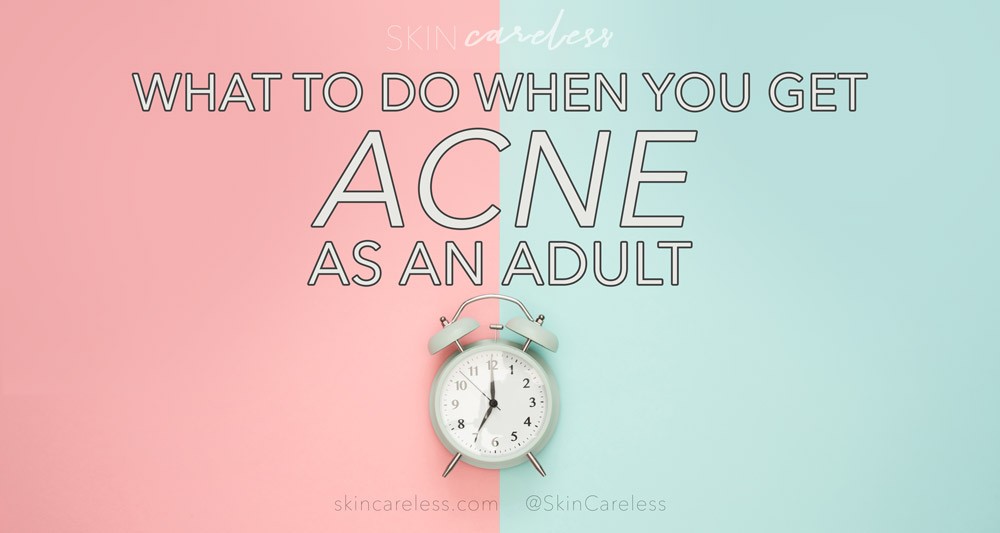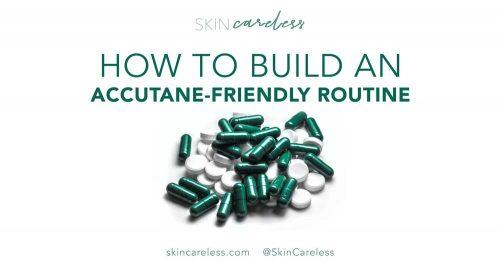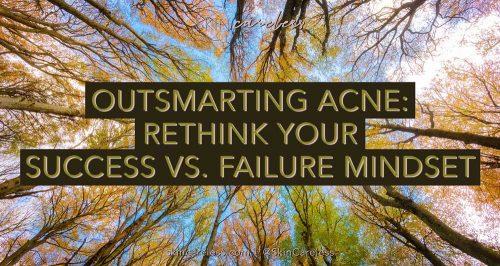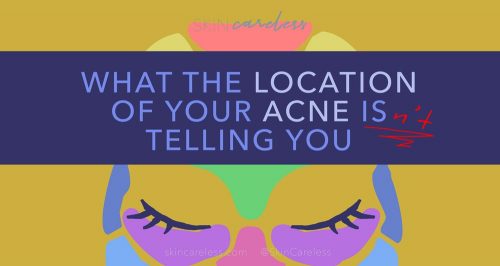Every teenager knows that acne is just part of the deal of growing up – same as broken hearts and shitty hairstyles.
But that all goes away when you turn 20, right? And surely by your 30s and 40s, nobody could possibly suffer from acne anymore? The world couldn’t be that cruel?
Enter: Fully-grown adults who haven’t had a skin issue in years, and for whom high school is a distant memory, and now as they enter their mid-life they’re seeing a WHOLE new side to their skin. What the heck?
It’s not uncommon for our skin to change throughout our lives. From childhood to teenagerdom to adulthood, things shift and transform. But most people picture going from spotty skin to normal, sensible skin, not the other way around!
So what exactly causes a sudden flare up of acne after 30, and what can you do to treat it?
What causes acne to appear later in life?
There’s often a combination of environmental stress, hormonal changes, and improper care when you’ve started experiencing acne in post-pubescent skin.
Hormonal changes across our lifespan
We as humans go through stages of life that are characterised by huge shifts in our hormonal balance. Puberty immediately comes to mind, but it’s not just that. The 30s are when many women go through pregnancy and lactation, and experience the associated major impact of that on estrogen, progesterone and testosterone levels. These fluctuations can trigger hormonal acne, just like those nasty breakouts you get when you’re PMSing.
But the overarching trajectory of hormones through mid to late life is that of a decline – specifically in oestrogen, the lack of which is what eventually leads to menopause.
Plunging hormone levels over time impacts collagen and production of basal skin cells – reducing natural resilience and thickness (more on this below). The pH of the skin rises thanks to reduced enzyme levels restricting creation of free fatty acids and other natural moisturising factors that make up the healthy acidic skin barrier. We’re gradually less able to buffer daily assaults of overly-alkaline substances like soap and bounce back as quickly as we once could. Skin without a balanced pH barrier is defenseless against infections like acne.
Built-up environmental damage
Middle age is when the lifestyle of your younger years start to catch up to you – in ways aside from poor life decisions like that really bad butterfly tattoo you swore to your mum was tasteful and small (spoiler alert: it wasn’t).
Your skin reflects how you treated it 10 years ago. Usually, our 20s are when we’ve lived large and enjoyed the most time outdoors, traveling and staying up late. The resulting stress, alcohol, pollution and sun exposure have been in the background, silently producing free radicals for years. (Plus, stress leads to hormone imbalances – it’s a vicious cycle!)
As a result of this damage, production of skin-supporting collagen and basal skin cells called ‘keratinocytes’ is all but halted, and this alongside hormonal losses causes the skin to thin and become delicate. Production of hyaluronic acid (a humectant), and glycosaminoglycan (a protein) also begins to drop. All together, this increases trans-epidermal water loss, which is when the moisture that keeps your skin cells plump and healthy evaporates into the air. Subsequent dehydration promotes infection, irritation and sensitivity which can invite acne and exacerbate the redness and inflammation it brings.
Slower cell turnover thanks to – yet again – oxidative cell damage leads to a buildup of dead cells on the surface of the skin. These loitering dead skin cells are part of the cocktail that clog pores and feed acne bacteria and cause them to proliferate even more quickly.
This general damage and ageing of all skin-supporting structures impairs blood circulation and the rate of wound healing, meaning acne hangs around for longer and leaves lasting marks and scars, adding fuel to the fire and making your skin look worse for longer.
Outdated skin care routines
One final cause of acne in your 30s and 40s and beyond is applying incorrect products and having a mismatched routine – like still using the same stuff from when your skin was younger and completely different, or forging ahead with rich anti-ageing creams too soon. It’s essential to stay on top of of your skin’s needs and the latest developments in skin care technology.
How to tackle adult-onset acne
All this is to say, acne is – at its core – an infection of the sebaceous glands, and as we get older our skin becomes weaker and more susceptible to damage and infection. So it’s imperative to treat both the causes and symptoms of ageing skin to fight back against pimples and prevent acne from taking over again.
As with any skin care goal, there’s no miracle product. It’s taken you nearly half a lifetime to get to where you are now, and you’ll need a minute to turn things back around. You need to rethink your routine long-term to suit your new skin issues. Aside from checking you’re not doing any of the skin care sins (which should be your first priority), and seeing a doctor to rule out any serious underlying hormonal imbalances, try out these tactics to see an improvement in middle-age acne.
Tactic #1: Include acids to encourage faster skin cell turnover.
Acids aren’t scary! Gentle Alpha Hydroxy Acids like AHA 7 Whitehead Power Liquid go on right after cleansing and work to loosen and remove those excess dead skin cells to keep the skin surface clear of debris. Beta Hydroxy Acids such as the BHA Blackhead Power Liquid will head into the pore to de-clog, disinfect and deflate any stubborn acne spots. See my review for these two CosRX products here. Keeping these ingredients in regular rotation will prevent acne from getting out of hand and create a much better canvas for the rest of your routine to build on!
Tactic #2: Add preventatives to stop further free radical damage.
Antioxidant serums such as The Ordinary’s Buffet, and a reliable, high-SPF sunscreen (my go-to at the moment is Naris Up Parasola) act as a daily buffer. They absorb environmental aggressors in the form of free radicals from the environment and defuse them, keeping your skin protected and youthful for as long as possible. The longer you can put off the inevitable effects of getting older, the better your skin will handle any acne that comes its way.
Tactic #3: Incorporate skin restoratives to improve skin texture.
Retinol (Vitamin A) overhauls your skin cells from the ground up, encouraging a healthy turnover rate, and can actually undo years of free radical damage. Using a product like Sunday Riley Luna Sleeping Night Oil with retinol just a few nights a week will get your skin acting like it used to, and hopefully take the edge of any adult acne you’re experiencing.
Tactic #4: Ensure your products suit your new skin type.
In terms of hydration, look for products that aren’t too heavy. Don’t be pressured into only using product lines that claim to be for mature skin – often they are filled with butters that are just too rich for many normal to oily skin types. You can get just as much moisture from light, water-based products!
Similarly, if you’ve been using the same highly perfumed, alcohol-filled toners and foaming cleansers since the 80s, it’s time to move graduate to gentler products. Repeated over cleansing can actually lead to dehydration, aggravate acne and stimulate excess oil production.
Tactic #5: Consider adding an anti-acne spot treatment.
No matter how perfect your routine is, everybody gets the odd cyst now and then. A 2.5% benzoyl peroxide cream from your local pharmacy is the gold standard for fighting this kind of sporadic and stubborn acne – almost every acne-prone teen in the world has used it at one point or another. Because it can be super drying and irritating (and bleach your sheets!), I’d recommend limiting its use to just a spot treatment for large, painful acne spots as needed.
There you have it! Growing up is fun, isn’t it?
Learning how to care for your skin all over again can be hard, especially since we all fall into bad habits over the years. Is this the first time you’ll be creating a skin care routine for yourself? I have a free planner you can use to remind yourself of all the steps you need to keep you on track! Simply fill out the form below to have it sent to your inbox right away.






[…] finally, Vitamin A, the king of anti-ageing. While in most forms it’s usually not technically an antioxidant, I […]